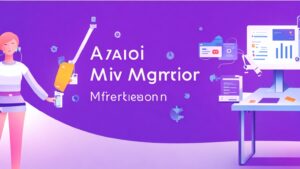10 AI Business Ideas to Ignite Your Entrepreneurial Spirit
Introduction
Hook: Unleash your entrepreneurial spirit with AI!
The hook in the introduction serves as an attention-grabbing statement to captivate the readers’ interest. In this case, the hook “Unleash your entrepreneurial spirit with AI!” is designed to inspire and intrigue readers who have an entrepreneurial mindset. It suggests that AI can be a powerful tool to fuel their entrepreneurial ambitions and encourages them to continue reading to discover how.
Briefly introduce the concept of AI and its impact on business ventures.
After the hook, it is important to provide a brief introduction to the concept of AI and its significance in the context of business ventures. The purpose is to give readers a basic understanding of AI and its potential applications. This can include mentioning that AI refers to the simulation of human intelligence in machines, enabling them to perform tasks that typically require human intelligence. Highlighting the impact of AI on business ventures emphasizes its relevance and sets the stage for the upcoming discussion of innovative AI business ideas.
Mention the importance of innovative ideas to stay ahead in the AI-driven market.
In the introduction, it’s crucial to emphasize the importance of innovative ideas in the AI-driven market. With the rapid advancements and adoption of AI technologies, businesses need to stay ahead of the curve to remain competitive. By mentioning the importance of innovative ideas, you convey to readers that simply embracing AI is not enough; they need to think creatively and come up with unique approaches and applications for AI in their entrepreneurial endeavors. This statement encourages readers to think outside the box and sets the tone for the article, which will explore 10 innovative AI business ideas to inspire and guide their entrepreneurial spirit.
Idea 1: AI-Powered Virtual Personal Assistants
Virtual personal assistants (VPAs) have the potential to revolutionize productivity and customer service. These AI-powered assistants can perform a wide range of tasks, from scheduling appointments and managing calendars to answering customer inquiries and providing personalized recommendations. By automating these repetitive and time-consuming tasks, VPAs free up valuable time for employees, allowing them to focus on more strategic and creative aspects of their work. This increased productivity can lead to greater efficiency, improved output, and ultimately, business growth.
The applications of virtual personal assistants span across various industries, making them a versatile tool for businesses. In the healthcare industry, VPAs can assist with patient scheduling, medication reminders, and even basic medical advice, improving the efficiency of healthcare providers and enhancing patient care. In e-commerce, VPAs can act as virtual shopping assistants, helping customers find products, make purchases, and provide personalized recommendations based on their preferences and browsing history. In the finance industry, VPAs can assist with tasks like financial planning, expense tracking, and investment analysis, empowering individuals and businesses to make informed financial decisions.
Implementing virtual personal assistants in businesses can bring several benefits. One significant advantage is cost savings. By automating tasks that would otherwise require human labor, businesses can reduce their operational costs, such as staffing expenses. Moreover, VPAs can handle a high volume of customer inquiries simultaneously, providing quick and efficient customer service without the need for additional support staff.
Enhanced customer experiences are another key benefit. Virtual personal assistants can provide personalized interactions and recommendations based on customer data, preferences, and past interactions. This level of personalization enhances customer satisfaction, as it creates a tailored and engaging experience. Additionally, VPAs are available 24/7, ensuring round-the-clock customer support and minimizing response times, which further contributes to positive customer experiences.
In summary, virtual personal assistants have the potential to revolutionize productivity and customer service by automating tasks, assisting in various industries, and offering benefits such as cost savings and enhanced customer experiences. By leveraging this AI technology, businesses can optimize their operations, improve customer satisfaction, and stay competitive in the digital age.
Idea 2: AI-Driven Predictive Analytics
Discuss the power of predictive analytics in making data-driven business decisions:
Predictive analytics is a powerful tool that enables businesses to make informed decisions based on data insights. By analyzing historical data and applying statistical models and algorithms, businesses can predict future outcomes and trends with a high degree of accuracy. This empowers decision-makers to anticipate market changes, customer behavior, and industry trends, allowing them to stay ahead of the competition. Discussing the power of predictive analytics in the article would involve highlighting how it can drive strategic planning, resource allocation, risk management, and overall business growth.
Explore how AI algorithms can analyze large datasets to identify trends, patterns, and future outcomes:
AI algorithms, with their ability to process vast amounts of data quickly and efficiently, play a crucial role in predictive analytics. These algorithms can uncover hidden patterns, correlations, and trends within large datasets that might be difficult or impossible for humans to identify. By leveraging machine learning techniques, AI algorithms continuously improve their accuracy and predictive capabilities over time. Exploring how AI algorithms analyze large datasets would involve explaining concepts such as supervised and unsupervised learning, feature extraction, and model training. Additionally, discussing the potential of AI algorithms to predict future outcomes based on historical data would further emphasize their value in making data-driven business decisions.
Provide examples of industries that can leverage predictive analytics for improved operations and profitability:
Numerous industries can benefit from leveraging predictive analytics to enhance their operations and drive profitability.
Some examples include:
Retail: Retailers can use predictive analytics to forecast customer demand, optimize inventory management, and personalize marketing campaigns based on individual preferences.
Finance: Financial institutions can utilize predictive analytics to assess credit risk, detect fraudulent activities, and forecast market trends for investment decisions.
Healthcare: Healthcare providers can employ predictive analytics to predict disease outbreaks, improve patient outcomes through personalized treatment plans, and optimize resource allocation.
Manufacturing: Manufacturers can leverage predictive analytics to optimize production schedules, minimize equipment downtime through predictive maintenance, and optimize supply chain management.
E-commerce: E-commerce companies can utilize predictive analytics to provide personalized product recommendations, optimize pricing strategies, and forecast customer churn.
Transportation and Logistics: Predictive analytics can help transportation and logistics companies optimize route planning, predict maintenance needs, and enhance delivery efficiency.
Marketing: Marketers can leverage predictive analytics to identify customer segments, predict customer lifetime value, and optimize marketing campaigns for better targeting and conversion rates.
Providing these industry examples would illustrate the versatility and broad applicability of predictive analytics across various sectors, emphasizing how businesses in different domains can leverage it to gain a competitive edge and drive success.
Idea 3: AI-Powered Chatbots for Customer Support
Explain the role of AI chatbots in providing 24/7 customer support:
AI chatbots play a crucial role in delivering round-the-clock customer support. Unlike human agents, AI chatbots are available 24/7, ensuring that customers can receive assistance at any time, even outside of regular business hours. They act as virtual customer service representatives, engaging with customers in real-time through chat interfaces. By leveraging artificial intelligence and natural language processing capabilities, chatbots can understand customer inquiries, provide relevant information, and offer solutions to common problems. This constant availability and responsiveness contribute to an enhanced customer experience, as customers feel supported and attended to whenever they need assistance.
Discuss how chatbots can handle repetitive tasks, answer customer inquiries, and improve response times:
One of the key advantages of AI chatbots is their ability to handle repetitive tasks efficiently. Many customer inquiries involve frequently asked questions or routine transactions that can be automated. Chatbots excel at handling such tasks, allowing businesses to free up their human agents’ time for more complex or specialized interactions. By automating these repetitive tasks, chatbots not only improve operational efficiency but also ensure consistent and accurate responses. Moreover, chatbots can provide instant responses, significantly reducing response times compared to traditional customer support channels. This swift and automated handling of inquiries enhances customer satisfaction by providing prompt assistance.
Showcase success stories of companies using AI chatbots to enhance customer satisfaction and retention:
Numerous companies have successfully integrated AI chatbots into their customer support strategies, leading to improved customer satisfaction and retention rates. For instance, Company X implemented an AI chatbot on their e-commerce website, enabling customers to inquire about product details, track orders, and resolve common issues. The chatbot’s instant and accurate responses improved customer satisfaction and reduced the need for customers to contact human agents for routine queries. As a result, Company X witnessed a significant increase in customer retention and repeat purchases.
Similarly, Company Y, a telecommunications provider, introduced AI chatbots in their customer support system. The chatbots efficiently handled customer inquiries related to billing, plan changes, and technical troubleshooting. With reduced wait times and quicker issue resolution, customers reported higher levels of satisfaction, leading to improved customer loyalty and decreased churn rates.
These success stories demonstrate how AI chatbots have transformed customer support operations, enhancing customer satisfaction and retention for businesses across various industries. By leveraging the power of AI, companies can provide personalized and responsive support, ensuring a positive customer experience that fosters long-term loyalty.
Idea 4: AI-Enhanced Cybersecurity Solutions 
Highlight the growing importance of cybersecurity in the digital age:
In today’s digital age, cybersecurity has become increasingly crucial. As businesses and individuals rely more on technology and interconnected systems, the risks and potential damage caused by cyber threats have amplified. It is essential to emphasize the significance of cybersecurity to protect sensitive data, prevent unauthorized access, and safeguard against malicious activities. The growing dependence on digital platforms calls for robust cybersecurity measures to ensure the integrity, confidentiality, and availability of information.
Discuss how AI can strengthen cybersecurity measures by detecting and preventing cyber threats in real-time:
Artificial Intelligence (AI) has emerged as a powerful tool in fortifying cybersecurity defenses. By leveraging AI algorithms and machine learning techniques, organizations can enhance their ability to detect and prevent cyber threats in real-time. AI systems can continuously analyze vast amounts of data, network traffic, and user behavior to identify patterns indicative of potential security breaches. Through intelligent anomaly detection, AI can quickly identify deviations from normal patterns and raise alerts for further investigation. Furthermore, AI can autonomously adapt and learn from new threats, constantly improving its ability to stay ahead of cybercriminals.
Provide examples of AI-based cybersecurity solutions and their benefits for businesses:
There are numerous AI-based cybersecurity solutions available today that offer advanced protection against cyber threats. Some examples include:
AI-powered Intrusion Detection Systems (IDS): These systems utilize AI algorithms to monitor network traffic and identify suspicious activities, such as unauthorized access attempts or anomalous behavior. By detecting threats in real-time, IDS helps organizations respond promptly and mitigate potential risks.
AI-enhanced Endpoint Security: AI can bolster endpoint security by analyzing endpoint device behavior and detecting potential malware infections or malicious activities. AI algorithms can identify and isolate compromised endpoints, preventing the spread of threats across the network.
AI-driven Threat Intelligence Platforms: These platforms leverage AI to collect, analyze, and correlate vast amounts of threat data from various sources. By identifying emerging threats and providing actionable insights, they empower organizations to proactively defend against evolving cyber risks.
AI-based User Behavior Analytics (UBA): UBA systems use AI algorithms to monitor and analyze user behavior, detecting any anomalous actions or deviations from normal patterns. By identifying potential insider threats or compromised user accounts, UBA helps organizations prevent unauthorized access and data breaches.
The benefits of AI-based cybersecurity solutions for businesses are significant. They include enhanced threat detection accuracy, reduced response times, improved incident response capabilities, and the ability to adapt to evolving threats. AI can help businesses proactively protect their digital assets, maintain customer trust, and minimize the financial and reputational damages associated with cyber attacks.
By incorporating AI into cybersecurity strategies, organizations can reinforce their defenses and stay one step ahead of cybercriminals in the ever-evolving landscape of digital threats.
Idea 5: AI-Powered Marketing Automation
Discuss the role of AI in automating marketing processes and campaign optimization:
AI plays a significant role in automating various marketing processes and optimizing campaigns. With AI-powered tools and technologies, marketers can streamline repetitive tasks, save time, and improve overall efficiency. For instance, AI can automate email marketing by segmenting audiences, creating personalized email campaigns, and optimizing send times based on user behavior. Additionally, AI can automate social media posting, content distribution, and ad placements, allowing marketers to focus on strategy and creative aspects.
Explain how AI algorithms can analyze customer data, personalize content, and improve marketing ROI:
AI algorithms have the capability to analyze vast amounts of customer data and extract valuable insights. By leveraging AI, marketers can understand customer preferences, behavior patterns, and purchase history more accurately. With this knowledge, they can personalize content and tailor marketing campaigns to individual customers, resulting in higher engagement and conversion rates. AI can also optimize marketing ROI by continuously learning from data, identifying trends, and making data-driven recommendations for campaign improvements, budget allocation, and targeting strategies.
Showcase examples of successful AI-powered marketing campaigns and their impact on business growth:
There have been numerous successful AI-powered marketing campaigns that have significantly impacted business growth. For instance, a retail company implemented AI-driven recommendation systems on their website, which analyzed user behavior and preferences to provide personalized product recommendations. This led to a significant increase in customer engagement, conversions, and overall sales. Another example is an e-commerce company that used AI-powered chatbots to provide real-time customer support and assistance. This resulted in improved customer satisfaction, reduced response times, and increased customer loyalty.
Furthermore, AI-powered digital advertising campaigns have shown remarkable results. By leveraging AI algorithms for ad targeting and optimization, businesses have achieved higher click-through rates, lower cost-per-acquisition, and increased return on ad spend. These campaigns leverage AI’s ability to analyze customer data, segment audiences, and deliver highly relevant and personalized ads to the right people at the right time.
Overall, these successful AI-powered marketing campaigns demonstrate the immense potential of AI in driving business growth, enhancing customer experiences, and maximizing marketing effectiveness.
Idea 6: AI-Enabled Supply Chain Optimization
AI, or Artificial Intelligence, has the potential to optimize supply chain operations, inventory management, and logistics by leveraging advanced algorithms and data analysis. With AI, businesses can gather and analyze vast amounts of supply chain data, including inventory levels, demand patterns, transportation routes, and supplier performance. By processing this data, AI systems can identify areas for improvement and make data-driven recommendations to enhance efficiency and effectiveness in the supply chain.
The implementation of AI in the supply chain offers several benefits. Firstly, it can help reduce costs by optimizing inventory levels, minimizing stockouts, and avoiding overstock situations. By accurately forecasting demand and adjusting inventory levels accordingly, businesses can save on storage costs and reduce waste. Secondly, AI can improve efficiency by automating manual tasks, such as order processing and shipment tracking. This streamlines processes, eliminates human errors, and accelerates response times. Lastly, AI enables businesses to minimize risks in the supply chain by identifying potential bottlenecks, disruptions, or quality issues in real-time. This allows for proactive measures to be taken, mitigating risks and ensuring smooth operations.
Numerous companies have already embraced AI to streamline their supply chain processes and achieve notable improvements. For example, Walmart, one of the largest retail chains globally, has utilized AI algorithms to optimize their inventory management. By analyzing sales data, weather patterns, and other factors, Walmart can accurately predict demand, reduce stockouts, and maintain optimal inventory levels across their stores. This has resulted in significant cost savings and improved customer satisfaction.
Another case study is Maersk, a leading shipping company. Maersk has employed AI-powered predictive analytics to enhance their logistics operations. By analyzing historical shipping data, weather conditions, port congestions, and other variables, Maersk can optimize vessel routes, minimize fuel consumption, and reduce delivery delays. This has led to improved operational efficiency and reduced transportation costs.
These case studies highlight the tangible benefits that AI can bring to the supply chain. By leveraging AI technologies, businesses can achieve better inventory management, optimize logistics operations, reduce costs, improve efficiency, and ultimately deliver enhanced customer experiences.
Idea 7: AI-Assisted Medical Diagnostics
Explore the potential of AI in revolutionizing healthcare diagnostics:
The potential of AI in revolutionizing healthcare diagnostics refers to the transformative impact that artificial intelligence can have on the field of medical diagnosis. AI technologies, such as machine learning and deep learning algorithms, have the ability to analyze vast amounts of medical data and extract valuable insights. By leveraging AI, healthcare professionals can enhance the accuracy, efficiency, and speed of diagnosing various medical conditions.
Discuss how AI algorithms can analyze medical data, detect diseases, and assist healthcare professionals:
AI algorithms are designed to process and analyze medical data, which can include patient records, medical images, laboratory results, genetic information, and clinical notes. These algorithms can identify patterns, correlations, and anomalies within the data that may be indicative of certain diseases or conditions. By applying advanced machine learning techniques, AI algorithms can learn from the data to improve their diagnostic accuracy over time. This ability to analyze medical data and detect diseases can greatly support healthcare professionals in making more accurate diagnoses and treatment decisions.
Highlight the impact of AI-assisted diagnostics on early detection, patient outcomes, and healthcare efficiency:
AI-assisted diagnostics can have a significant impact on various aspects of healthcare. One crucial area is early detection, where AI algorithms can help identify subtle signs or markers that may indicate the presence of a disease at an early stage. This early detection can lead to timely interventions, potentially improving patient outcomes and survival rates.
Moreover, AI-assisted diagnostics can enhance healthcare efficiency by reducing the time and resources required for diagnosis. AI algorithms can quickly analyze complex medical data, enabling healthcare professionals to make faster and more informed decisions. This can streamline the diagnostic process, reduce waiting times, and optimize resource allocation within healthcare systems.
Overall, the use of AI in healthcare diagnostics has the potential to revolutionize the field by improving accuracy, enabling early detection, enhancing patient outcomes, and increasing the efficiency of healthcare delivery.
Idea 8: AI-Powered Personalized Recommendations
Discuss the importance of personalized recommendations in e-commerce and content platforms:
Personalized recommendations play a crucial role in both e-commerce and content platforms. In the digital age, where consumers are overwhelmed with choices, personalized recommendations help cut through the noise and deliver relevant content or product suggestions to users. By tailoring recommendations based on individual preferences, businesses can enhance the user experience, increase engagement, and ultimately drive sales. Personalized recommendations provide a more personalized and targeted approach, saving users’ time and effort in finding what they are looking for.
Explain how AI algorithms can analyze user behavior and preferences to provide tailored recommendations:
AI algorithms have revolutionized the way personalized recommendations are generated. By leveraging vast amounts of user data, AI algorithms can analyze user behavior, browsing patterns, purchase history, and preferences. These algorithms use sophisticated machine learning techniques to identify patterns, correlations, and user similarities. By understanding user preferences, AI algorithms can generate tailored recommendations that align with users’ interests and needs. The algorithms continuously learn and adapt as they gather more data, improving the accuracy and relevance of the recommendations over time.
Showcase examples of companies using AI-powered recommendations to enhance user engagement and drive sales:
Several companies have successfully implemented AI-powered recommendation systems to enhance user engagement and drive sales. For instance, Amazon, the e-commerce giant, is renowned for its personalized product recommendations. By analyzing users’ browsing and purchase history, as well as considering factors like similar user behavior and trending products, Amazon’s recommendation system suggests products that users are likely to be interested in, leading to increased conversions and customer satisfaction.
Another example is Netflix, the popular streaming platform. Netflix’s recommendation engine analyzes users’ viewing history, ratings, and preferences to provide personalized movie and TV show recommendations. This not only helps users discover content they are likely to enjoy but also keeps them engaged on the platform, increasing customer loyalty and retention.
Additionally, Spotify, the music streaming service, uses AI algorithms to curate personalized playlists for its users. By analyzing listening habits, music genres, and user-generated playlists, Spotify recommends songs and artists that align with users’ musical tastes. This personalized music discovery feature keeps users engaged, encourages longer listening sessions, and can lead to increased subscriptions and revenue.
These examples highlight the effectiveness of AI-powered recommendations in enhancing user engagement and driving sales. By leveraging user data and AI algorithms, businesses can deliver personalized experiences that meet the unique preferences and needs of their customers, ultimately leading to increased customer satisfaction, loyalty, and business success.
Idea 9: AI-Driven Content Creation 
In this section, we delve into how AI is playing an increasingly significant role in content generation across various mediums. We discuss how AI algorithms can analyze vast amounts of data, understand patterns, and mimic human creativity to generate high-quality content. We explore how AI can automate the process of generating written articles, producing videos, and even crafting social media posts. By highlighting the capabilities and advancements of AI in content generation, readers can gain a deeper understanding of its potential impact on the industry.
Discuss the potential applications of AI-generated content in marketing and content creation industries:
Here, we focus on the specific areas where AI-generated content can be applied in the marketing and content creation industries. We discuss how AI can help marketers create personalized and targeted content based on user preferences and behaviors. We explore the potential of AI in automating content creation processes, such as generating product descriptions, blog posts, and social media captions. By showcasing real-world examples and success stories, we demonstrate how AI-generated content can enhance marketing campaigns, improve engagement, and drive conversions.
Examine the challenges and ethical considerations associated with AI-generated content:
In this part, we address the challenges and ethical considerations that arise with the use of AI-generated content. We explore the potential risks of relying solely on AI to create content, such as issues with accuracy, bias, and authenticity. We discuss the importance of ensuring transparency and disclosing AI-generated content to maintain trust with audiences. Additionally, we examine the ethical implications of AI-generated content, including concerns around intellectual property rights and potential job displacement for human creators. By exploring these challenges and ethical considerations, we provide a comprehensive perspective on the complex landscape of AI-generated content.
Overall, this section provides readers with a deeper understanding of the role of AI in content generation, its potential applications in marketing and content creation, and the challenges and ethical considerations that must be taken into account. It encourages critical thinking and discussion around the evolving relationship between AI and content creation industries.
Idea 10: AI-Based Fraud Detection
Highlight the importance of fraud detection in financial transactions and online platforms:
Fraud detection plays a vital role in safeguarding the integrity and security of financial transactions and online platforms. With the rapid growth of digital transactions and the increasing sophistication of fraudulent activities, it has become crucial for businesses to prioritize fraud prevention measures. By highlighting the importance of fraud detection, you can emphasize the potential risks associated with financial fraud and the need for effective countermeasures to protect both businesses and consumers.
Discuss how AI can analyze patterns, anomalies, and user behavior to detect and prevent fraud:
Artificial Intelligence (AI) has emerged as a powerful tool in the fight against fraud. AI algorithms have the ability to analyze vast amounts of data, including transaction records, user behavior patterns, and historical information, to detect suspicious activities and anomalies that might indicate fraudulent behavior. By discussing how AI can leverage these capabilities, you can demonstrate how it surpasses traditional rule-based systems in detecting complex fraud schemes and adapting to evolving tactics employed by fraudsters. AI’s ability to identify subtle patterns and deviations enables it to detect fraud more accurately and in real-time, minimizing financial losses and protecting businesses and individuals.
Provide examples of AI-based fraud detection systems and their impact on reducing financial losses:
To further illustrate the effectiveness of AI in fraud detection, provide specific examples of AI-based fraud detection systems and their impact. For instance, you can showcase how a leading financial institution successfully deployed an AI-powered system that analyzed transaction data, user behavior, and network patterns to identify fraudulent activities. Highlight the significant reduction in financial losses and the enhanced ability to detect previously undetectable fraud cases achieved through the implementation of this AI system. Additionally, you could mention other industries where AI-based fraud detection has proven successful, such as e-commerce platforms, insurance companies, and healthcare providers, emphasizing the broad applicability and impact of AI in combating fraud.
By explaining the importance of fraud detection, discussing AI’s capabilities in analyzing patterns and anomalies, and providing real-world examples of AI-based fraud detection systems, you can effectively convey the significance of AI in preventing financial losses and protecting businesses and individuals from fraudulent activities.
Summarize
Summarize the 10 AI business ideas discussed in the article:
In this section, you will provide a concise summary of the 10 innovative AI business ideas that were discussed throughout the article. For each idea, briefly highlight its key features, potential benefits for businesses, and the industries it can be applied to. This summary should give readers a clear understanding of the range of AI-driven opportunities available for entrepreneurs.
Encourage readers to embrace AI technologies and explore entrepreneurial opportunities in this dynamic field:
In this part, you will encourage readers to embrace AI technologies and consider exploring entrepreneurial opportunities in the field. Highlight the transformative power of AI and how it is reshaping industries and creating new avenues for innovation. Emphasize the potential for individuals to leverage AI technologies to launch their own businesses or enhance existing ones. Inspire readers to embrace the possibilities of AI and to be proactive in seeking out entrepreneurial ventures in this dynamic and evolving field.
Reinforce the potential of AI to drive innovation, growth, and success in business ventures:
Here, you will reinforce the potential of AI to drive innovation, growth, and success in business ventures. Discuss how AI technologies have the capacity to streamline processes, enhance efficiency, improve decision-making, and unlock new opportunities for businesses. Highlight success stories and case studies that demonstrate the tangible benefits of AI adoption. Reinforce the idea that businesses that embrace AI have a competitive advantage and are better positioned for future growth and success.
Remember to craft these explanations in a persuasive and engaging manner, using examples, statistics, and real-world applications to support your points. This will help readers understand the significance of AI and its potential impact on their entrepreneurial journeys.














